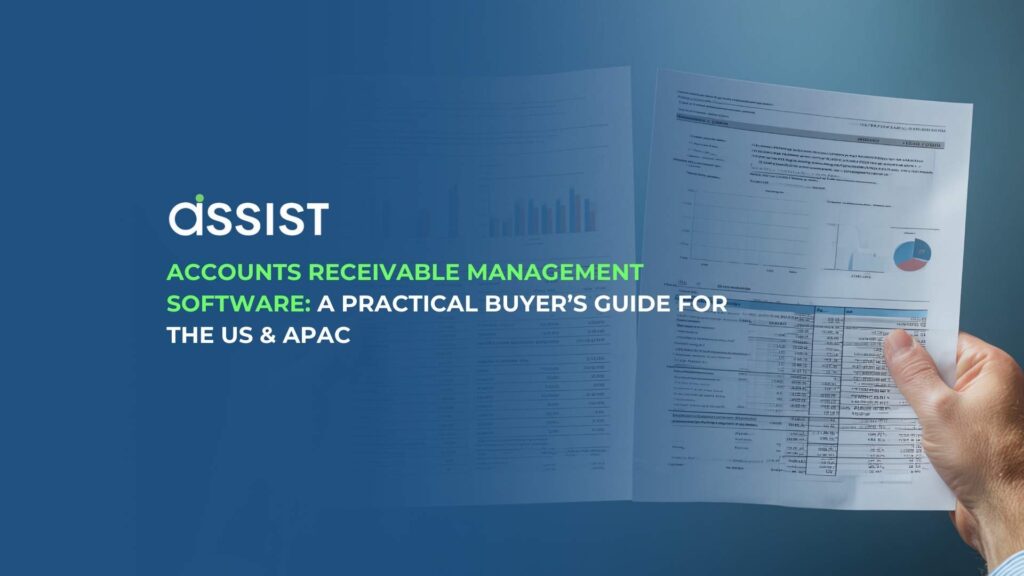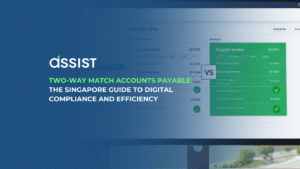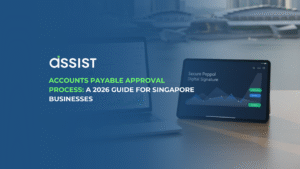If you are evaluating accounts receivable management software and want a concise, expert walkthrough that moves from definitions to a shortlist and a confident next step, this guide is for you. We will review what AR software covers, how to map features to workflows, how US and APAC payment and compliance requirements change your checklist, how to build a comparison matrix, what KPIs to target, and how to implement without headaches. Read with me to the end so we can align on a smart, vendor neutral plan before you test a free trial.
What “Accounts Receivable Management Software” Actually Covers
Accounts receivable software coordinates the full journey from credit approval to cash in the bank. At its core, it helps you set credit limits, generate and deliver invoices, automate reminders and collections sequences, manage disputes and deductions, match incoming payments to open items, and post cleanly to your ERP. If you are still framing the boundary between payable and receivable processes, this short primer on the difference between accounts payable vs accounts receivable can help align teams before you evaluate tools.
Maturity Model: From Manual to Fully Automated AR
Manual, spreadsheet driven
Signs you are here include CSV exports from bank portals, manual dunning emails, fragile VLOOKUPs, and long month end closes. Risks include inconsistent follow ups, write offs, and opaque forecast accuracy.
Semi automated
You have templatized reminders, adopted basic imports, and may use a portal for statements. Wins include fewer lost invoice escalations. Gaps remain with partial payments and multi remittance matching, and disputes often live in long email chains.
Fully automated
The system drives the cadence, covering credit rules, digital invoice delivery, omnichannel dunning across email, SMS, and WhatsApp, a self service portal, structured dispute handling, AI assisted cash application, and straight through posting to ERP. Your team focuses on exceptions, not data wrangling.
Use these stages to self identify where you are today and which outcomes such as DSO, CEI, and auto match percentage are realistic in the next quarter.
Try Assist.biz for Free Account Receivable Management SoftwareFeature to Workflow Mapping, What to Look For at Each Step
Credit and onboarding
Look for configurable credit policies, soft checks, and segment based limits. Automated KYC where required and customer master field validation reduce downstream errors.
Invoice creation and delivery
Seek flexible templates, multi entity and multi currency support, tax logic for GST and VAT, and e invoice readiness where mandated. Upstream controls matter too, and if you are formalizing approvals, this overview of invoice approval workflows shows how AP and AR checks can align before revenue recognition.
Collections and dunning
You will want sequences by risk profile, promise to pay tracking, call queues, and integrated notes. Channel breadth is key, and email, SMS, and WhatsApp are table stakes in many APAC markets.
Disputes and deductions
Prioritize features that shorten cycle time such as reason codes, evidence attachments, internal and external collaboration threads, and SLA timers.
Cash application
Insist on multi source remittance capture from email, portals, and PDFs, bank feeds, lockbox or virtual accounts, and AI assisted matching with human in the loop. Aim for high first pass match rates even with short pays and multi invoice remittances.
Reconciliation and reporting
Expect ERP grade posting, variance handling, audit trails, and dashboards for CEI, aging buckets, and collector productivity.
Document these capabilities by workflow, not as a flat feature list, so stakeholders see how the system actually accelerates cash.
US vs APAC: Payment Rails, Compliance, and Localization You Cannot Ignore
United States
ACH dominates recurring B2B, wires and cards fill gaps, and RTP is growing. Expect robust NACHA file handling, remittance parsing from email and portals, and deep integrations for QuickBooks and NetSuite. If you are a QuickBooks shop, confirm that your shortlisted tools have truly native sync by reviewing the integration with QuickBooks details, and Xero users should do the same with integration specifics for Xero.
APAC
Local rails matter, including PayNow and PayNow QR in Singapore, FPX in Malaysia, and UPI in India. Mobile user experience, QR payments, and WhatsApp reminders can materially improve collections. You will also contend with language, currency, and tax diversity, along with emerging e invoice mandates. If Malaysia is in scope, this plain English explainer on e invoicing and tax compliance is a solid briefing, and Singapore teams can explore how InvoiceNow, Peppol affects invoice exchange and reconciliation.
Across both regions, plan for data residency, privacy frameworks such as GDPR and PDPA, currency aware collections, and audit ready logs.
Decision Tree: Is This the Right Category for You, and Which Tier
Start with five qualifiers.
- Monthly invoice volume. If you are under one thousand, a lightweight AR suite may be enough. Between one and ten thousand, consider mid market platforms. Over ten thousand with complex disputes often requires enterprise grade cash application and collections tooling.
- Cross border exposure. If more than a quarter of payments are international, prioritize multi rail support, FX handling, and country specific dunning.
- Dispute complexity. Frequent short pays, deductions, or chargebacks demand robust dispute workflows and reason code analytics.
- ERP and ecosystem. The tighter the ERP integration, the fewer reconciliation headaches. Validate mappings, posting logic, and error handling.
- Collections staffing. If you have a team, queue management and analytics matter, if you do not, automation depth becomes the deciding factor.
Use your answers to place yourself into SMB, mid market, or enterprise tiers and narrow your shortlist accordingly.
Try Assist.biz for Free Account Receivable Management SoftwareComparison Matrix Guide, Build Your Own
Create a weighted spreadsheet and score contenders on the following.
- Payment rails and methods, ACH, RTP, card, wires, PayNow, FPX, UPI, and QR codes
- ERP connectors, QuickBooks, Xero, NetSuite, with validated data models and posting flows
- Customer portal and user experience, self service statements, disputes, attachments, and internationalization
- AI cash application, expected auto match percentage, handling of multi remittance PDFs, short pays, and partials
- Collections tooling, sequence logic, channel breadth across email, SMS, and WhatsApp, and promise to pay capture
- Security and compliance, SOC 2, ISO 27001, GDPR and PDPA, SSO and MFA
- Implementation effort and TCO, time to live, professional services, internal resource needs, and 12 to 36 month cost
- Support and SLAs, response times, uptime history, and regional coverage
If you are benchmarking platform fit against the broader finance stack, skimming a concise features and benefits overview can help you articulate what good looks like when AR sits beside AP and expense controls.
KPIs, Benchmarks, and a Simple ROI Worksheet
Core KPIs
- DSO, Days Sales Outstanding, which measures how fast you convert invoices to cash
- CEI, Collection Effectiveness Index, which captures how completely you collect within a period
- Average days delinquent and write off percentage for loss visibility
- Auto match rate for cash application, first pass accuracy
Typical improvement ranges
Moving from manual to semi automated often reduces DSO by five to ten percent and boosts on time payments. Moving to fully automated can deliver ten to twenty percent DSO reduction and eighty to ninety five percent first pass match, contingent on remittance quality and bank feeds.
Back of the envelope ROI
- Estimate monthly invoice count times average invoice value to get billed revenue per month
- Multiply by DSO reduction in days divided by thirty to estimate cash unlocked
- Add hours saved from automation across collections and cash application times hourly fully loaded rate
Capture these numbers in your matrix so finance can pressure test scenarios before you talk to vendors. If you want a quick sanity check on budgets during shortlisting, you can glance at a transparent pricing page to anchor ranges before building total cost of ownership.
Try Assist.biz for Free Account Receivable Management SoftwareImplementation Playbook: How to Go Live Without the Headaches
Who is involved
Finance lead as process owner, IT for integrations and SSO, vendor success for enablement, and a project sponsor such as a CFO or Controller.
Data preparation
Clean the customer master including IDs, terms, and contacts, map opening AR, and standardize invoice and remittance formats. Establish naming conventions early to prevent reconciliation noise.
Integrations
Line up ERP connectors, payment service providers, and bank feeds. Decide where truth lives for credit limits, payment terms, and dunning status.
Collections readiness
Draft sequences by risk tier and write day by day templates for email, SMS, and WhatsApp. Pilot on a safe cohort before expanding.
Testing and cutover
Use a sandbox, reconcile test payments, and validate posting and reversals end to end. Plan a soft launch with hypercare for two to four weeks.
If you want a feel for typical onboarding steps, this step by step free trial walkthrough shows what a low friction start looks like, and teams that need formal assurances often skim the certifications page before connecting ERPs or bank feeds.
Safeguards, Security, and Compliance, What Your Auditor Will Ask
Auditors look for complete audit trails, least privilege roles, SSO and MFA, encryption at rest and in transit, and tested backups with clear RPO and RTO. For regulated industries or cross border data flows, validate data residency options and PDPA or GDPR controls. Ask vendors for uptime history, third party attestations such as SOC 2 and ISO 27001, and a sample evidence pack. If you are collecting questions from stakeholders, routing them to a consolidated FAQ hub keeps your evaluation thread on track.
Real World Use Cases for US and APAC
US B2B SaaS with ACH and RTP
Goals include faster cash, fewer support tickets, and clearer MRR recognition. Must haves include automated reminders by segment, ACH and RTP rails, a self service portal, and high match rates on partials and credits.
Singapore distributor leveraging PayNow QR
Goals include matching high volume, small ticket payments with minimal manual handling. Must haves include QR based invoice delivery, WhatsApp reminders, and PayNow aware reconciliation with strong mobile user experience.
Malaysia manufacturer preparing for e invoice mandates
Goals include compliance with minimal disruption to collections. Must haves include GST logic, Peppol or InvoiceNow style exchange where relevant, and portal workflows that incorporate mandate required fields. For a deeper dive on operational implications, the e invoicing and tax compliance explainer is a helpful companion read, and if you want to see automation at work in an operational setting, this case study collection surfaces real world patterns you can borrow.
Try Assist.biz for Free Account Receivable Management SoftwareBuyer’s Checklist, Download Friendly Summary
- Map your current maturity and pick a one quarter improvement target for DSO, CEI, and auto match percentage
- Build a workflow based requirements list across credit, invoicing, collections, disputes, cash application, and reconciliation
- Add US and APAC localization for rails, languages, currencies, invoice standards, and data residency
- Define security and compliance expectations for SSO, MFA, audit logs, and attestations
- Assign implementation roles, prepare data, and schedule a sandbox
- Validate ERP mappings and error handling, and test full reversals
- Finalize a comparison matrix with weighted criteria and an ROI worksheet
If you want to visualize these checkpoints in an actual product sequence, a short tour of how it works can help you sanity check your plan.
Conclusion
The most reliable path to results is straightforward. Assess your maturity, map requirements to real workflows, weigh US and APAC localization needs, quantify target KPIs, and hold vendors to a comparison matrix that includes security and implementation effort. With that structure, your shortlist becomes obvious and you will walk into demos knowing exactly what good looks like.
Try Assist for Yourself
If you want to pressure test the ideas in this guide with a working stack, you can get hands on with a free trial using this how to sign up walkthrough or book a short demo with our team.
If you prefer to browse first, a quick tour of our solution and features and benefits outlines where AR fits next to your accounting stack, and if you are scoping budgets, the pricing page is fully transparent.
For background on who we are, our about page explains our approach to security, regional coverage, and customer support. When you are ready, you can register to use Assist and try it for free from those pages.
Try Assist.biz for Free Account Receivable Management Software



